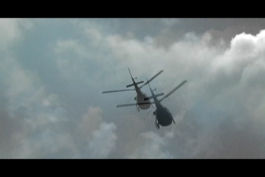
Thursday, July 19, 2007
A screening programme curated by Heike Liss und Nomi Talisman
Bay Area Dance Music Videos
This video screening introduces works by San Francisco/Bay Area artists investigating the relationship of image and sound.
Videos by:
Glock & Shpiel (Dreamboat Where Are You?): Another Day, Another Madcap Adventure, 2006, 3:33 min
Punk Pop duo want to learn how to fly….
Claudia Esslinger, Breathing Lessons, 2006, 10:00 min
Breathing Lessons poetically traces a longing for oxygen through one family's history. It uses narration, symbolic movement, visceral props and rhythmic music to evoke a mood of memory and loss.
Wenhua Shi, Crimson Haze, 2005, 6:00 min
Crimson Haze is a meditation upon the color, decay and rhythm, which presents as the disorderly order. It also impacts the tone and tint style from the Silent era of film history. This short Experimental film recalls narrative and structure of D.W. Griffith's Intolerance.
Lindsay Benedict, Band o' Butchers, 2006, 3:00 min
This piece is about the brotherhood that takes place in a regular day's work. Hand-splicced 16mm film shot in an area of Brooklyn that will soon be a manicured promenade.
Les Stuck, bars + tone, 2006, 5:46 min
SMPTE Color bars and a 1kHz test tone morph continuously into the image and sound of a beach sunset-a conceptually simple transformation which provides a site for consideration of numerous dualities. The bars are a utilitarian image not meant to be seen; the beach sunset is a sought-after image of such widely-accepted beauty that it has become a cliché. The bars consist of sharp rectangles of pure colors; the sunset consists of fuzzy areas of complex colors. Both images represent the color spectrum in their own way, which provides a strategy for the transformation.
Marc Horowitz, I Invented the Internet, 2006, 1:35 min
"I Invented the Internet" was made in response to Al Gore claiming he invented the internet. I thought that it would make a great musical number. I'm sorry I can't sing. enjoy.
dud, old house, 2006, 3:42 min
old house is an improvised story about a returning to the old house. It was performed on November 5, 2006 at dudland by Mark Briggs (electronics), Herb Heinz (guitar, voice), Franz Keller (visuals), Craig Latta (bass), Claudine Naganuma (dance), Richard Smith (drums), and Tim Walters (bass). Video and audio production by Herb Heinz.
Roger Ngim, Easy to Be Hard, 2006, 3:50 min
The superimposition of a plaintive pop song reveals the semaphoric meaning of a regional American dance form in this video made from salvaged and appropriated material.
Ruth Echkland, Rusalka, 2006, 3:30 min, Whirl, 20007, 0:38 min
‘Rusalka’ was inspired by Dvorak’s opera of the same name, with stylistic nods to Degas, this video reinvents the fairytale of the water nymph living in a forest lake who longs to be human to win the love of the Prince. This contemporary nymph needs no one but herself and her rhythmic attunement to her world, as she effortlessly flows between land and water. With her running shoes underneath her tutu, she is also no Ophelia, but has the strength, determination and grace to meet life’s challenges. The music is a beat composed, scratched and sampled by Matt DiFonzo.
In ‘Whirl’ highly altered image and ambient sound are designed to create a portrait and a breathless tribute. This brief video encapsulates the essence of the energy and athleticism of dance competitions, dance-skating, whirling dervishes and the frenetic dance of life, itself. Sound design is by the artist.
Heike Liss & Patrice Scanlon, Flowerfist, 2006, 5:00 min, Fancy Footwork, 2007, 5:00 min
Visual artist Heike Liss and musician/composer Patrice Scanlon have been collaborating on a series of dance/music videos for the last 2 years. ‘Flowerfist’ and ‘Fancy Footwork’ are their latest productions.
Nomi Talisman, The last Thing before the Last, 2006, excerpt
‘The last Thing before the Last’ is a series of short video pieces that explores the failure of systems and its’ crisis. The work combines sound from public archives (such as the UN General Assembly, US Courts, etc) and current footage that was shot on ordinary locations, depicting everyday events, that are influenced by mass media images.
Michael Trigilio, Thanks for Giving My Number Back, 2006, 2 excerpts
These music-video excerpts are from a longer work called _Thanks for Giving My Number Back_. The video explores the thin lines between love and death, fantasy and reality, hope and helplessness. Equal parts self-portraiture and science fiction, the story shapes itself into a tangle of chuckles, heartache, and anxiety.
Gail Wight, National Agenda, 2007, 3:15 min.
This work is similar to some video pieces I made in the late 80s, on secrecy and the CIA, the obliteration of nature, and the misfiring of well-intended efforts. I was angry then, and I'm still angry now. The issues have changed a little, but not all that much. When it comes to the government, the issues seem like they've hardly changed at all. Still, my anger doesn't help. In much of the work I've done since that time, I've addressed issues of pain, brutality, well-intentioned mistakes, horror . . . but always through humor. Humor is a way for me to get close to things that are otherwise too painful, too infuriating. How to address our nation's leaders' calculated negligence on the topic of global warming? Chocolate, kazoos, sand paper, and a heat gun. Go nowhere on Earth Day.